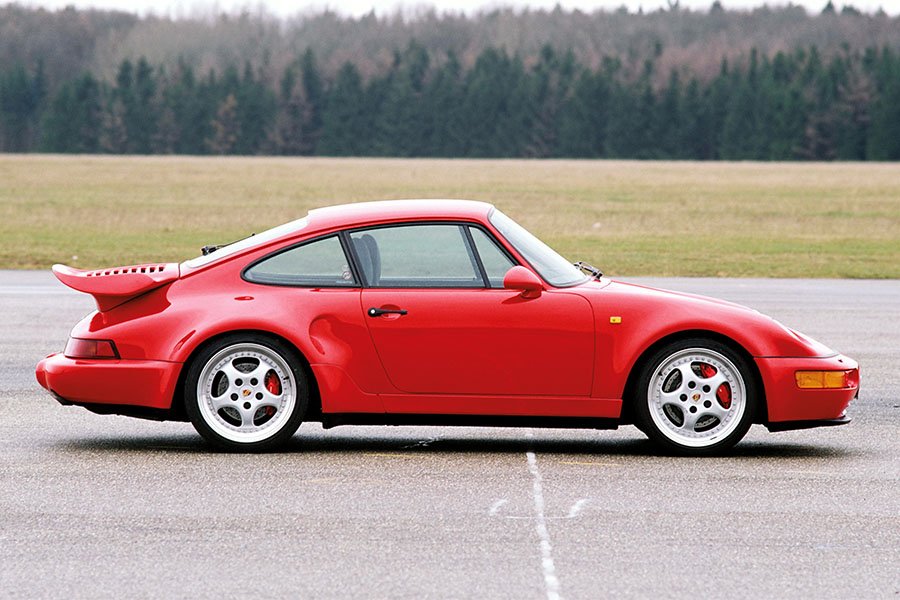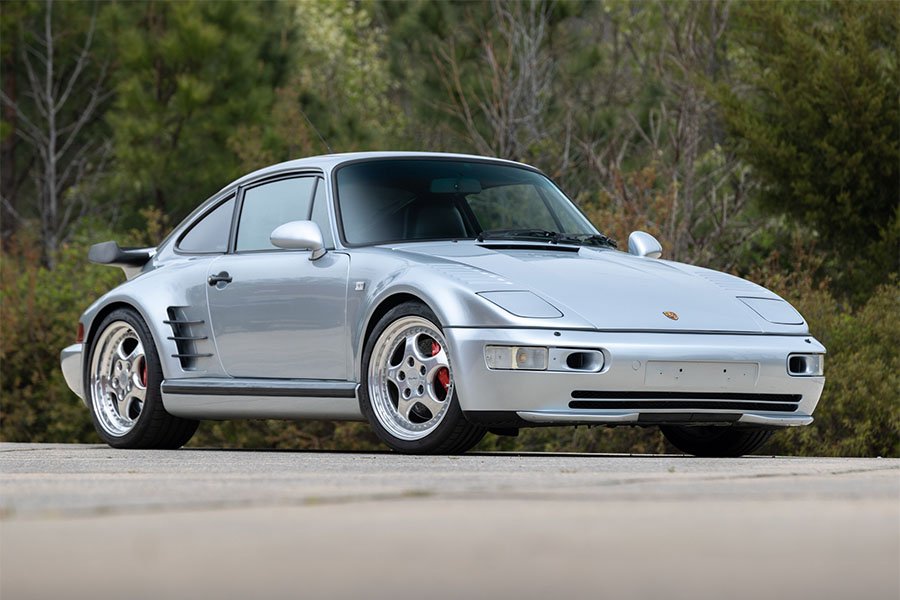Guide: Porsche 911 3.6 Turbo S Flachbau - a Historical & Technical Appraisal
/BACKGROUND
As Porsche began what seemed an inexorable slide towards bankruptcy during the early-to-mid 1990s, the influx of cash generated by the firm’s Exclusive department became ever more important.
Porsche’s Exclusive division started life in late 1980 as the Sonderwunsch or Special Wish department. It was established in response to a growing number of requests for highly customised vehicles; during the years prior, many customers had paid vast sums to outside companies such as BB, Kremer and DP for just such machinery. By contrast, Porsche had indulged only a tiny number of their best VIP clients.
The Sonderwunsch department was established at the Zuffenhausen repair and restoration department (Werk 1) where, under the direction of Rolf Sprenger, customer racing cars like the 911 RSR, 934 and 935 had previously been assembled. More space was freed up when the customer racing department moved to Weissach in 1981.
Over the next few years, an ever increasing number of 911 Turbos (plus the odd normally aspirated SC or Carrera) were transformed with the Sonderwunsch department’s new Flachbau bodywork. A variety of other bespoke cosmetic and mechanical upgrades were also offered; if a customer wanted the full range of enhancements available, the list price of a standard car would more than double.
When Porsche began to offer the Flachbau front end as an official option from late 1986, the Sonderwunsch name was switched to Exclusive and, for a few years, the department became busier than ever.
That flurry of activity was followed by something of a lull when the 964-based 911 came fully on stream. However, when Porsche revived the 964 Carrera RS at Geneva in March 1991, Rolf Sprenger pitched the idea of a hot RS-inspired 911 Turbo that would be developed entirely by the Exclusive department.
Since its launch, the Carrera RS had proven the one 964 model that had sold better than anticipated; at the time, Porsche was in the early stages of a rapid financial decline brought about by inefficient manufacturing techniques, poor trading conditions and an outdated range. It was thought that a limited run of highly tuned and significantly lightened 911 Turbos would provide a much-needed boost to the balance sheet and get the Exclusive department back up to operational capacity.
Sprenger got the nod in January 1992 and a prototype was unveiled at Geneva two months later. A limited run of 80 cars was sanctioned but the new car, dubbed the 911 3.3 Turbo S Lightweight, proved sufficiently popular that 86 were ultimately built between 1992 and 1993.
The next model to emerge from the Exclusive department was a batch of 15 964 Speedsters built later in 1993 with wide-arched Turbo-style bodywork.
Then came another 964 Turbo-based machine that was conceived to use up 93 chassis that were left over at the end of production. By this time, the original 3.3-litre 964 Turbo (used as the basis for the aforementioned Turbo S Lightweight) had been superseded by a 3.6-litre version.
The new 911 3.6 Turbo S would be offered in two iterations, both of which featured the X88 Power Kit and a host of cosmetic enhancements. One retained the 911’s trademark rounded front fenders and was offered at a 20% premium over the list price of a standard 3.6 Turbo. The other was priced at a whopping 60% more and marked a return for arguably the Exclusive department’s raison d’etre: the Flachbau.
This latest Flatnose (sometimes dubbed Flachbau Version II) accounted for 76 of the 93 Turbo S cars assembled at Porsche Exclusive and, unlike the 1992-1993 Lightweight, came with a regular Comfort-type interior.
Production began at the Porsche Exclusive workshop in September 1993 when the new 993-based 911 was introduced.
BODYWORK
During the 1980s, the 935-inspired Flachbau front end went through two different iterations.
The first arrived in 1980. It incorporated flattened front fenders and a single-piece fibreglass front apron with four rectangular lights under a slim black rubbing strip and an elaborately contoured chin spoiler with a pair of slender cooling ducts.
The second variant arrived in 1983 and incorporated the standard 1974 to 1989 front impact bumper, below which was a flattened apron with a large rectangular intake and a pair of fog lights. The headlights were now retractable units located on the flattened front fenders, behind which were banks of six vents per side.
This latest Flachbau ushered in another new style. Like some of those early tuning companies (most notably BB), it adopted handsome uncovered 928-style headlights that tilted forwards when activated.
Other special Porsche Exclusive features added to these cars included a custom front lip spoiler, body coloured front intakes (instead of fog lights) that fed fresh air to the oil cooler and brakes, a body coloured rear spoiler and air inlets in the rear fenders.
The rear spoiler, rear fender inlets and front oil cooler / brake ducts had all previously been seen on the 3.3-litre Turbo S Lightweight.
ENGINE / TRANSMISSION
As part of their ultra high specification, every Turbo S was equipped with the X88 Power Kit that had been available as an option on the standard 3.6-litre Turbo.
The Power Kit comprised a special Type M64/50S engine that came with uprated cylinder head inlet and exhaust ports, a modified inlet manifold and spacer flanges, high-lift camshafts, a further improved oil cooler, a larger KKK K27 turbocharger with more efficient intercooler, uprated valve timing, uprated fuel injectors and a four outlet exhaust system.
The flywheel and clutch were also new and a 40% self-locking differential was fitted instead of the standard 20% version. Front and rear shock mounts were reinforced.
Peak output was 380bhp at 5750rpm and 384lb-ft at 5000rpm (up from 355bhp at 5500rpm and 382lb-ft at 4200rpm).
As per every 911 engine of the modern era, the M64/50S was an all-alloy power unit that employed single overhead camshafts, two valves per cylinder and dry-sump lubrication. Unlike the 3.3-litre engine fitted to the first 964 Turbo, the 3.6-litre unit shared the same crankshafts, connecting rods, crankcases and cylinder heads with the rest of the 964 range.
Differences to the normally aspirated 964 engine included new pistons, high-lift camshafts, a reduced 7.5:1 compression ratio (down from 11.3:1) and single instead of twin-plug ignition. There was also an LuK flywheel, an uprated oil cooler, the latest Bosch DME engine management and a repositioned oil tank (moved to in front of the rear axle to allow more room for a bigger silencer).
The base model 3.6 Turbo’s KKK K27 turbocharger and associated plumbing (to include the intercooler) had been imported from the outgoing model but with turbo pressure cranked to 0.85 bar (up from 0.7). Full boost now came on stream at 3500rpm.
Displacement was identical to the rest of the 964 range: 3600cc thanks to a bore and stroke of 100mm and 76.4mm respectively.
Transmission was through the existing G50/52 five-speed manual gearbox (with revised ratios), a single-plate clutch and a Carrera RS rear axle with the aforementioned 40% locking limited-slip differential.
CHASSIS
The Turbo was based on the rear-wheel drive 964 Carrera 2’s steel bodyshell.
Sport suspension (code M030) was fitted as standard (apart from to North American-bound cars where a taller ride height was mandated). The M030 kit included shorter springs and stiffer dampers that resulted in a 20mm lower than normal ride height.
The 3.6 Turbo (like every 964) used a different suspension arrangement than the old G-series 911 – gone was the old torsion bar arrangement in favour of coil sprung dampers. A MacPherson strut arrangement was retained at the front while the back end used the cast-aluminium semi-trailing arms originally seen with the 930. Anti-roll bars were fitted at either end.
Like the Carrera RS, Turbo S Lightweight and base model 3.6 Turbo, the new Turbo S used cross-drilled and ventilated discs of 322mm up front and 299mm at the back. The Anti-lock Brake System was similarly re-calibrated compared to regular 964s and a hydraulic instead of vacuum servo was fitted along with a bigger master cylinder.
In a similar fashion to the Turbo S Lightweight, the brake calipers were painted red as standard.
Handsome three-piece Speedline wheels were also imported from the Turbo S Lightweight. They measured 18 x 8-inches at the front, 18 x 10-inches at the rear and were originally shod with Yokohama A-008P tyres. Most Turbo S Flachbaus came with polished rims (offered as a no cost option).
A 77-litre fuel tank was installed underneath the front lid.
INTERIOR
Inside, the Turbo S Flachbau was identical to the standard 3.6-litre Turbo.
Airbags were fitted as standard along with an updated air-conditioning system, but otherwise, nothing much had changed and the 964’s cockpit architecture harked back to the early 1970s.
The seats, instrument binnacle, dash and door panels were all imported from the old 3.2 Carrera / 930.
The familiar five gauge instrument layout comprised a central tachometer with analogue boost gauge flanked to the right by a speedometer and clock. To the left were combined instruments for oil pressure / oil temperature and fuel / oil level.
Although the dash was carried over from the previous model, there were some extra warning lights and subtle revisions to the instrumentation (which was now back lit).
Air-conditioning, electric windows and electric mirrors were standard along with an onboard computer that featured a digital boost indicator.
OPTIONS
Porsche offered a vast array of optional extras to include coloured wheel centres, titanium or black brake calipers, a sunroof, a long-range 92-litre fuel tank, ruched leather, an extended centre console, Sports seats, heated seats, eight-way electric seats, bucket seats, a choice of audio systems, mobile phone preparation, wooden or aluminium cockpit inserts and extended leather.
Out of range exterior and interior colours could be ordered via Porsche Exclusive.
WEIGHT / PERFORMANCE
The Turbo S Flachbau was quoted at 1470kg which was identical to every other forced induction 964.
However, thanks to its additional 25bhp and improved aerodynamics, performance figures were slightly improved.
Top speed went from 175mph to 179mph while the 0-62mph time dropped from 4.7 seconds to 4.6 seconds.
JAPANESE VERSION
Those examples of the Turbo S Flachbau destined for the Japanese market differed visually.
Instead of the new 928-style headlight configuration, these cars adopted the arrangement used between 1983 and 1989 with conventional pop-up units behind which were bank of six vents per side.
They also had the old style running board-style side skirts and vertical rear fender intakes with a trio of satin black blades from the same era.
END OF PRODUCTION
Production of the Turbo S Flachbau ran from September 1993 until February 1994.
76 were built.
This figure comprised 39 for North America (option code X85), 27 for the international market (X84) of which twelve were right-hand drive and ten for Japan (X83).
Text copyright: Supercar Nostalgia
Photo copyright: Porsche - https://www.porsche.com, Dutton Garage - https://duttongarage.com/ & Road Scholars - https://roadscholars.com/




































